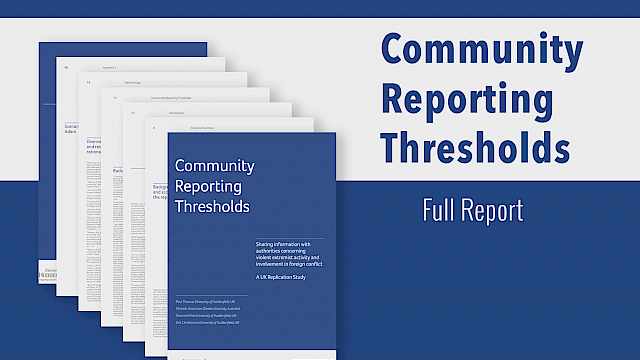This document reviews the literature on public-facing counter-terrorism strategic communication, drawing in insights from analogous contexts and specialist areas. The aim of the literature review is to provide an overview of current theory and practice that is instructive for the wider STARS project’s research objectives, particularly objective:
- Develop new data on the effectiveness of strategic government communication to inform publics and deter terrorist risks and threats, accounting for the influence of key actors and contextual factors.
The review broadly followed a Rapid Evidence Assessment (REA) approach. Interdisciplinary and specialist peer-reviewed databases were searched using combinations of key terms, with a supplementary targeted search of grey literature, practitioner/specialist outlets, high profile academic journals in terrorism, key communication texts, and web search engines across the 2011-2021 time period.
Key concepts and theory
In attempting to capture a definition fitting for the contemporary information environment, Van Ruler (2018) states that:
strategic communication should be conceptualized as an agile management process in which the focus is on feeding the arenas in which meanings are presented, negotiated, constructed, or reconstructed for strategy building and strategy implementation, and on testing strategic decisions by presenting and negotiating these in a continuous loop.
(p.379-380)
This understanding of strategic communication captures the dynamic process through which communication flows from ‘senders’ to ‘receivers’, and reflects broader theoretical development in the study of strategic communication over recent decades. In short, this development can be tracked from early conceptions of strategic communication as an act of dissemination - an ‘a to b’ linear process - to current understandings of communication as ‘engagement’ which, informed by the implications of social media as an increasingly central communicative medium, merits ‘connection, participation, and involvement’ (Johnston, 2018) from individuals traditionally considered ‘audiences’ (Johnston and Taylor, 2018).
At the same time, this trajectory emphasises the challenges practitioners face when seeking to use strategic communication to communicate with the public for specific purposes and outcomes. Strategic counter-terrorism communication may seek various outcomes, such as to deter hostile actors, to raise awareness of terrorist threats and risks, to call the public to some kind of action, or simply to reassure of the state’s protective capabilities. These desired outcomes are evident in the content and framing of specific public campaigns, but their effects will always depend on how they play out in an evolving and increasingly ‘noisy’ information environment, within which audiences themselves participate.
Framed by such considerations, in a study commissioned on behalf of the ‘5 eyes’ governments, into the social organisation of public reactions to terror attacks, Innes et al. (2018) identified how the aims and objectives of post-event strategic communications evolve and adapt. Thus, depending on what has happened, they shift through various phases from managing the immediate crisis, through evidence collection, managing any reputational harms and on to promoting public reassurance. This temporal dimension starts to enrich and nuance our understandings of the different roles and functions that influence how, when, and why governments construct public communications on the topic of terrorism.
In acknowledging both the wider strategic communication research and specific counter-terrorism communicative challenges, our approach is framed by Innes’ (2014) work on the role of ‘signal crimes’, ‘signal events’ and ‘control signals’ in shaping public perceptions and political decision-making. Informed by Erving Goffman’s (1971) concept of ‘normal appearances’, the ‘signal crimes perspective’ holds that particular communicative acts are ascribed especial significance and visibility, so that when they are experienced either directly or indirectly, they induce behavioural, cognitive and affective responses, that influence how people interpret the distribution of risks and threats in their social environments. The point is that not all events hold equal capacity and capability to influence public perceptions and understanding. Further, perceptions of normality, risk and threat, are strongly influenced by the idiosyncrasies and qualities of a particular context. It is within this multi-disciplinary theoretical framing that the thematic review is grounded.
What does the literature tell us?
The review demonstrates that a wide range of linked factors impact on how public-facing CT communication campaign materials are ‘read’ and understood. Some key recurring themes were identified that can be used to inform the design and delivery of current and future campaigns. The full STARS report containing our empirical data is available below.
Read more
Banas, J.A. and Richards, A.S. (2017) Apprehension or motivation to defend attitudes? Exploring the underlying threat mechanism in inoculation-induced resistance to persuasion, Communication Monographs, 8(2): 164-178.
Boudewyns, V., Turner, M., & Paquin, R. S. (2013) Shame-free guilt appeals: Testing the emotional and cognitive effects of shame and guilt appeals, Psychology and Marketing, 30(9):811-825.
Byrne, J., Gormley-Heenan, C., Morrow, D. and Sturgeon, B. (2015) Public attitudes to Peace Walls (2015): Survey Results. Ulster University: pws.pdf (ulster.ac.uk)
Carson, J. V., and Politte, H. (2021) Implicit Bias Within Public Reporting: A Virtual Reality Experiment Examining ‘Suspicious’ Activity, Crime & Delinquency, 67(12): 2135–2162.
Carter, H., Drury, J., Amlôt, R. (2020) Recommendations for improving public engagement with pre-incident information materials for initial response to a chemical, biological, radiological or nuclear (CBRN) incident: A systematic review, International Journal of Disaster Risk Reduction, 51(2020):101796.
Carter, H., Weston, D., Symons, C. and Amlot, R. (2019) Public perceptions of pre-incident information campaign materials for the initial response to a chemical incident: The ‘Remove, Remove, Remove’ campaign, Disaster Prevention and Management, 28(5):565-584.
Carthy, S.L. and Sarma, K.M. (2021) Countering Terrorist Narratives: Assessing the Efficacy and Mechanisms of Change in Counter-narrative Strategies, Terrorism and Political Violence. DOI: 10.1080/09546553.2021.1962308
Cavatora, E. and Groom, B. (2020) Does deterrence change preferences? Evidence from a natural experiment, European Economic Review, 127. https://doi.org/10.1016/j.euroecorev.2020.103456
Coaffee, J. (2019) Discipline, morality and the façade of localism in action: The war on terror and the regulation of UK community resilience, International Journal of Law, Crime and Justice. DOI: https://doi.org/10.1016/j.ijlcj.2019.100372
Coaffee, J., and Fussey, P. (2015) Constructing resilience through security and surveillance: The politics, practices and tensions of security-driven resilience, Security Dialogue, 46(1): 86–105.
Cohen-Louck, K. (2019) Perception of the Threat of Terrorism, Journal of Interpersonal Violence, 34(5), 887–911.
Crijns, H., Cauberghe, V. and Hudders, L. (2017) Terrorism threat in Belgium: The resilience of Belgian citizens and the protection of governmental reputation by means of communication, Public Relations Review, 43(1): 219-234.
Fay, S., & Crutchfield, R. (2019). Perceptions of ‘others,’ risk, and counter terrorism-related informal social control. Australian & New Zealand Journal of Criminology, 52(3), 315–333.
Fishbein, M.R, Azjen, I. (2010) Predicting and Changing Behavior: The Theory of Reasoned Action Approach. New York: Psychology Press.
Gauntlett, L., Amlôt, R., & Rubin, G. J. (2019) How to inform the public about protective actions in a nuclear or radiological incident: a systematic review, The Lancet Psychiatry, 6(1): 72-80.
Gin, J.L., Stein, J.A., Heslin, K.C. and Dobalian, A. (2014) Responding to risk: Awareness and action after the September 11, 2001 terrorist attacks, Safety Science, 65(2014): 86-92.
Goffman, E. (1971) Relations in Public: Microstudies of the Public Order. New York: Basic Books.
Guttman, N. (2015) Persuasive appeals in road safety communication campaigns: Theoretical frameworks and practical implications from the analysis of a decade of road safety campaign materials, Accident Analysis & Prevention, 97(2016): 298-308.
Haner, M., Sloan, M.M., Pickett, J.T. and Cullen, F.T. (2021) When Do Americans ‘See Something, Say Something’? Experimental Evidence on the Willingness to Report Terrorist Activity, Justice Quarterly, 39(5): 1079-1103.
Heath, R.L., Lee, J., Lemon, L.L. (2019) Narratives of risk communication: Nudging community residents to shelter-in-place, Public Relations Review, 45(1):128-137.
Heath, R.L., Lee, J., Palenchar, M.J., Lemon, L.L. (2017) Risk Communication Emergency Response Preparedness: Contextual Assessment of the Protective Action Decision Model, Risk Analysis, 38(2): 333-344.
Herovic, E., Sellnow, T.L. and Sellnow, D.D. (2020) Challenges and opportunities for pre-crisis emergency risk communication: lessons learned from the earthquake community, Journal of Risk Research, 23(3): 349-364.
Innes, H. and Innes, M. (2021) De-platforming disinformation: conspiracy theories and their control, Information, Communication & Society, DOI: 10.1080/1369118X.2021.1994631
Innes, M. (2014) Signal Crimes: Social Reactions to Crime, Disorder and Control. Oxford: OUP.
Innes, M. (2020) Techniques of disinformation: Constructing and communicating ‘soft facts’ after terrorism, British Journal of Sociology, 71(2): 284-99.
Innes, M., Innes, H., Dobreva, D., Chermak, S., Huey, L. and McGovern, A. (2018) From Minutes to Months: A rapid evidence assessment of the impact of media and social media during and after terror events. Available from: https://orca.cardiff.ac.uk/id/eprint/120650/1/M2M+Report+[Final].pdf
Ivanov, B., Burns, W.J., Sellnow, Petrun Sayers, E.L., Veil, S.R. and Mayorga, M.W. (2016) Using an inoculation message approach to promote public confidence in protective agencies, Journal of Applied Communication Research, 44(4): 381-398.
Jarvis, L., and Lister, M. (2013) Vernacular Securities and Their Study: A Qualitative Analysis and Research Agenda. International Relations, 27(2): 158–179.
Jarvis, L., and Lister, M. (2016) What would you do? Everyday conceptions and constructions of counter-terrorism, Politics, 36(3): 277–291.
Jeong, B.K., Yoon, T. and Khan, S.S. (2021) Improving the Effectiveness of Anti-Piracy Educational Deterrence Efforts: The Role of Message Frame, Issue Involvement, Risk Perception, and Message Evidence on Perceived Message Effectiveness, Journal of Theoretical and Applied Electronic Commerce Research, 16(3): 298-319.
Johnson, K.A. (2018). Toward a Theory of Social Engagement. In Johnston, K., and Taylor, M (Eds.). (2018). The handbook of communication engagement (pp.17-32). NJ: Wiley Blackwell.
Johnson, K.A., Taylor, M. and Ryan, B. (2020). Emergency management communication: The paradox of the positive in public communication for preparedness. Public Relations Review, 46(2):101903.
Johnston, K., and Taylor, M (Eds.). (2018). The handbook of communication engagement (pp.17-32). NJ: Wiley Blackwell.
Johnston, K., Ryan, B. and Taylor, M. (2019) Mapping approaches to community engagement for preparedness in Australia (Report No. 515). Bushfire and Natural Hazards CRC, Australia.
Jong, W. (2020) Evaluating Crisis Communication. A 30-item Checklist for Assessing Performance during COVID-19 and Other Pandemics, Journal of Health Communication, 25(12): 962-970.
Kaviani, F., Young, K.L., Robards, B. & Koppel, S. (2020) Understanding the deterrent impact formal and informal sanctions have on illegal smartphone use while driving, Accident Analysis and Prevention, 145(2020): 105706.
Keenan, K. (2016) Security is going to work: Everyday geographies, organizational traps, and the public administration of anti-terrorism policy, Environment and Planning A: Economy and Space, 48(2): 239–255.
Keenan, K. (2018) Rethinking place in the study of societal responses to terrorism: Insights from Boston, Massachusetts (USA), Urban Studies, 55(2): 461–480.
Kule, A., Demir, M., Ekici, N. and Akdogan, H. (2021) Perceptions of Generation Z regarding Terrorism: A Cross-Regional Study, Studies in Conflict & Terrorism, DOI: 10.1080/1057610X.2021.1894737
Landau, M.J., Arndt, J., & Cameron, L.D. (2018) Do Metaphors in Health Messages Work? Exploring Emotional and Cognitive Factors, Journal of Experimental Social Psychology, 74: 135-149.
Lindekilde, L., Pearce, J.M., Parker, D. and M.B. Rogers (2021) ‘Run, Hide, Tell’ or ‘Run, Hide, Fight’? The impact of diverse public guidance about marauding terrorist firearms attacks on behavioral intentions during a scenario-based experiment in the United Kingdom and Denmark, International Journal of Disaster Risk Reduction, 60(2021):102278.
Lindell, M.K., Perry, R.W. (2012) The protective action decision model: Theoretical modifications and additional evidence, Risk Analysis (2012) 32: 616–632.
MacKay M., Colangeli, T., Thaivalappil, A., Del Bianco, A., McWhirter, J., Papadopoulos, A. (2021) A Review and Analysis of the Literature on Public Health Emergency Communication Practices, Journal of Community Health, 13 :1–13.
Parker, D., Pearce, J.M., Lindekilde, L. and Rogers, M.B. (2019) Challenges for Effective Counterterrorism Communication: Practitioner Insights and Policy Implications for Preventing Radicalization, Disrupting Attack Planning, and Mitigating Terrorist Attacks, Studies in Conflict & Terrorism, 42(3): 264-291.
Pearce, J.M., Lindekilde, L., Parker, D. and Rogers, M.B. (2019) Communicating with the Public About Marauding Terrorist Firearms Attacks: Results from a Survey Experiment on Factors Influencing Intention to ‘Run, Hide, Tell’ in the United Kingdom and Denmark, Risk Analysis, 39(8): 1675-1694.
Pearce, J.M., Parker, D., Lindekilde, L., Bouhana, N. and Rogers, M.B. (2020) Encouraging public reporting of suspicious behaviour on rail networks, Policing and Society, 30(7): 835-853.
Perko, T., Thijssen, P., Turcanu, C. and Baldwin, V.G. (2014) Insights into the reception and acceptance of risk messages: nuclear emergency communication, Journal of Risk Research, 17(9): 1207-1232.
Rice, C. and Taylor, M. (2020) ‘Reconciliation Isn’t Sexy’: Perceptions of News Media in Post-Conflict Northern Ireland, Journalism Studies, 21(6): 820-837.
Rosenboim, M., Benzion, U., Shahrabani, S. and Shavit, T. (2012) Emotions, Risk Perceptions, and Precautionary Behavior Under the Threat of Terror Attacks: A Field Study Among Israeli College Students, Journal of Behavioral Decision Making, 25(3): 248-256.
Ruggiero, A. and Vos, M. (2015) CBRN Terrorism Crises, Journal of Contingencies & Crisis Management, 23(3): 138-148.
Salerno, D. (2017) The politics of response to terror: the reshaping of community and immunity in the aftermath of 7 July 2005 London bombings, Social Semiotics, 27(1): 81-106.
Silva, J. R., Duran, C., Freilich, J. D. and Chermak, S. M. (2019) Addressing the myths of terrorism in America. International Criminal Justice Review, 30(3), 302–324.
Thomas, P., Grossman, M., Christmann, K. and Miah, S. (2020) Community reporting on violent extremism by ‘intimates’: emergent findings from international evidence, Critical Studies on Terrorism, 13(4): 638-659.
Truelove, V., Freeman, J., Szogi, E., Kaye, S., Davey, J. and Armstrong, K. (2017) Beyond the threat of legal sanctions: What deters speeding behaviours? Transportation Research Part F: Traffic Psychology and Behaviour, 50(2017): 128–136.
Unnever, J. D. and Cullen, F. T. (2010) The social sources of Americans’ punitiveness: A test of three competing models, Criminology; An Interdisciplinary Journal, 48(1): 99–129.
van Ruler, B. (2018) Communication Theory: An Underrated Pillar on Which Strategic Communication Rests, International Journal of Strategic Communication, 12(4):367-381.
Villegas, J. and Morton, C.R. (2020) Controversial Conversations: The Emotions Evoked by Anti-Terrorism Advertising, Journal of Current Issues & Research in Advertising, 41(2): 229-242.
Wirtz, P.W. and Rohrbeck, C.A. (2017) Efficacy for Dealing With Terrorism Precautionary Behavior: Laying the Groundwork for Communication Effectiveness, Journal of Health Communication, 22(10): 829-838.
Wood, M.W., Mileti, D.S., Kano, M., Kelley, M.M., Regan, R. and Bourque, L.B. (2011) Communicating Actionable Risk for Terrorism and Other Hazards, Risk Analysis: An International Journal, 32(4):601-615.
Zaller, J. (2006) The Nature and Origins of Mass Opinion. New York: Cambridge University Press
Copyright Information
As part of CREST’s commitment to open access research, this text is available under a Creative Commons BY-NC-SA 4.0 licence. Please refer to our Copyright page for full details.
IMAGE CREDITS: Copyright ©2024 R. Stevens / CREST (CC BY-SA 4.0)






